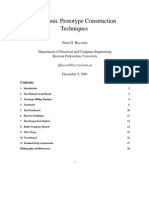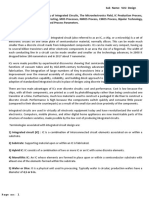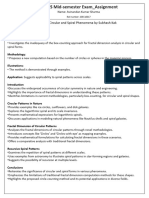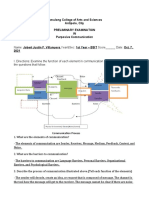Nano-Dies For Cable Compacting - Why Do They Work?
Nano-Dies For Cable Compacting - Why Do They Work?
Uploaded by
Chaitanya ShakyaCopyright:
Available Formats
Nano-Dies For Cable Compacting - Why Do They Work?
Nano-Dies For Cable Compacting - Why Do They Work?
Uploaded by
Chaitanya ShakyaOriginal Description:
Original Title
Copyright
Available Formats
Share this document
Did you find this document useful?
Is this content inappropriate?
Copyright:
Available Formats
Nano-Dies For Cable Compacting - Why Do They Work?
Nano-Dies For Cable Compacting - Why Do They Work?
Uploaded by
Chaitanya ShakyaCopyright:
Available Formats
Nano-Dies for Cable Compacting Why Do They Work?
Nano-Dies are Different:
A Nano-Die is constructed by first manufacturing a Tungsten Carbide die, then coating the working surface
of the die with two or three extremely fine layers of diamond in a CVD process. The crystalline structure at
the surface of a Nano-Die is quite different from the surface of a PCD die.
PCD material is manufactured with the particles pointing in all directions at random, with a range of particle
sizes distributed around the mean particle size.
Nano-Dies are manufactured with the same sized nanocrystalline diamond particles locked together in a
pattern. This is from where the Nano-Die derives its enormous hardness and strength.
When a Nano-Die fails, it is not like a Tungsten Carbide or PCD die in which a process of steady wear
causes the die to go out of tolerance. A Nano-Die holds +0 tolerance throughout its working life. When it
finally fails, it is due to collapse of the diamond surface caused by metal fatigue in the Tungsten Carbide
foundation material. A Nano-Die typically holds its diameter +0 for 500-800 km [say 300-500 miles] of
cable compacted. In some cases, the die will run for 1,000 km [say 620 miles] of cable compacted.
Nano-Dies Create New Possibilities:
There are many variables in the process of cable compacting. What you want is to hit the
Cable Electrical Resistance Target every time. What you get is a spread of results, much
wider than you would like. It is not always easy to see exactly what factors are involved to cause
such a spread of results, but we suggest a few:
(a) Dies - variation due to wear.
(b) Dies - failure to change on time when wear occurs.
(c) Variations in resistivity of the raw material.
(d) Temperature variations.
(e) Damage to micro-structure of the conductors (caused
by dies or by compacting too tightly)
(f) Variability in performance of compacting machinery.
Here is an experiment that is rarely performed. But it throws
a lot of light on the truth about cable manufacture. Consider the result if 1,000 reels of cable were
manufactured to the same specification. All normal die changes and maintenance are performed. Results
are recorded in a histogram format. The spread of results might appear as indicated in Figure 1. The results
are shown that would be obtained by a company who had long experience of manufacturing these particular
reels of cable to this particular specification. The cable has been designed to ensure that the Electrical
Resistance Test is passed every time. We often hear of a 5% Safety Factor being applied to raw material
to ensure that the Resistance Test is passed, but the truth is as shown in Fig. 1. The results are spread in the
form of a histogram and the cable is designed to place the upper
tail of the distribution right on the Target Resistance.
Now imagine a second experiment. Replace the dies with
Nano-Dies but leave everything else the same (as far as
possible). Imagine that another 1,000 reels of cable are
manufactured. The spread of results is noticeably different
this time (Figure 2). The most important difference is that
there is now a significant gap between the upper tail of the
distribution and the Target Resistance. Call this gap .
In Figure 2, notice that Nano-Dies have significantly reduced the spread of results. This probably means that
the original dies were the main cause of the results being spread widely in Figure 1. Also, the mean
electrical resistance of the cable is reduced (i.e. the electrical resistance where the distribution is highest).
We suggest two reasons for these improvements:
1. Nano-Dies hold +0 tolerance for 500 to 800 km of cable compacted (say 300 to 500 miles).
2. Nano-Dies have lower surface friction than PCD or Tungsten Carbide dies. Hence they do less
damage to the micro-structure of the individual conductors.
[More information at: http://www.nano-die.com/Nano-Dies-Cable.pdf ]
Taking Advantage of the New Information:
We really do not think that a die-maker has any place telling a cable manufacturer what he has to do next.
What follows is just to complete the picture. Of course it is not necessary to actually manufacture 2,000
reels of cable just to make the above points. But the discussion is statistical in nature, and statisticians love
big numbers. Back in the real world, cable manufacturers frequently adjust their designs incrementally,
based on just a few measurements. In any case, it is now possible to make small adjustments to the design of
the cable to optimize production for the new conditions presented as a result of using Nano-Dies. The dual
objective is (a) Manufacture of fully compliant cable and (b) Conservation of raw material.
The small changes may include adjustments to the diameters
of individual conductors, or to the number of individual
conductors, or to the diameters of the stranding and compacting
dies, or all of these things. But the objective is
to push Figure 2 to the right, so that final cable resistance is
still sure to be less than the Target Resistance, but not
enormously less. What we want is to re-design for =0 as
shown in Figure 3, exactly as we had in Figure 1.
The reward is better raw material utilization. Up to 2-3%
improvement is frequently achieved in this way. These savings are highly significant.
If your plant is already using PCD dies for compacting and stranding, this does NOT mean that the above
benefits cannot be achieved. For larger diameters where PCD dies simply cannot be manufactured or are
simply too expensive to even consider, Nano-Dies provide the full benefits noted above.
For the smaller diameters where PCD dies are still sometimes used, Material Utilization improvements up to
1-2% are achievable by replacing PCD dies with Nano-Dies. In other words, PCD dies are better than
Tungsten Carbide dies, but their performance in cable compacting and stranding is still inferior to the
performance of Nano-Dies. 1-2% raw material saving is highly significant. And please keep in mind that
the cost of a Nano-Die is 3-6 times less than the cost of the equivalent PCD die.
Nano-Diamond America, Inc.
2025 Woodbrook Court, Charlottesville, VA U.S.A.
Tel: +1 (434) 220-0435 Fax: +1 (804) 980-7770
e-mail: admin@nano-die.com
website: www.nano-die.com
You might also like
- 《Proofs》Document330 pages《Proofs》liupenzi06No ratings yet
- 深圳市海雷新能源产品目录 高清Document20 pages深圳市海雷新能源产品目录 高清iveslizhiranNo ratings yet
- Ebook Campbell Essential Biology 5Th Edition Simon Test Bank Full Chapter PDFDocument36 pagesEbook Campbell Essential Biology 5Th Edition Simon Test Bank Full Chapter PDFtristandoyledtnpkozbgj100% (22)
- Seminar Report On VLSIDocument21 pagesSeminar Report On VLSIGaurav Jaiswal75% (4)
- 3.1 Explain Basic Cable Types, Their Features, and Their PurposeDocument21 pages3.1 Explain Basic Cable Types, Their Features, and Their PurposeEd St James0% (1)
- Weld Like a Pro: Beginning to Advanced TechniquesFrom EverandWeld Like a Pro: Beginning to Advanced TechniquesRating: 4.5 out of 5 stars4.5/5 (6)
- Introduction To MetrologyDocument55 pagesIntroduction To Metrologypatel ketan92% (36)
- Nano Diamond Coated Dies: - and Where They Fit For Cable Stranding & CompactingDocument4 pagesNano Diamond Coated Dies: - and Where They Fit For Cable Stranding & CompactingDanu MamlukatNo ratings yet
- Bend Radius For CableDocument6 pagesBend Radius For CableTamjid KabirNo ratings yet
- Optical Fibre Technician Figures-Chapter7Document10 pagesOptical Fibre Technician Figures-Chapter7Parag ShrivastavaNo ratings yet
- AnixtureDocument2 pagesAnixturemanojj65No ratings yet
- QTR Ch8Document6 pagesQTR Ch8Lim Chia SeangNo ratings yet
- Cable Bending RadiusDocument2 pagesCable Bending RadiuspushkargopalNo ratings yet
- Copper-Wire-Bond-Failure-MechanismsDocument8 pagesCopper-Wire-Bond-Failure-MechanismskatrinkkNo ratings yet
- S6 Design Guide 05Document14 pagesS6 Design Guide 05EduardoNo ratings yet
- SCOD Unit FirstDocument34 pagesSCOD Unit Firsttkartikeya44No ratings yet
- File 1696992905 GUSBAS202131582 L1 SemiconductorWafersDocument5 pagesFile 1696992905 GUSBAS202131582 L1 SemiconductorWafersÃMĪT KUMAR SINGHNo ratings yet
- DNet Noise Immunity White PaperDocument12 pagesDNet Noise Immunity White PaperviufertNo ratings yet
- Semi-Conductor Presentation-DelVecchio and HenselDocument17 pagesSemi-Conductor Presentation-DelVecchio and HenselNagarjun RajputNo ratings yet
- Se Doc 17556Document9 pagesSe Doc 17556moradborhani54No ratings yet
- High Performance M Layer PCBsDocument9 pagesHigh Performance M Layer PCBsGanesan SNo ratings yet
- Welcome To Yagi-WorldDocument27 pagesWelcome To Yagi-WorldbooksNo ratings yet
- Optics Communications: Yu Cheng, Qingrong Han, Jean-Noel MaranDocument4 pagesOptics Communications: Yu Cheng, Qingrong Han, Jean-Noel MaranGerman ArleyNo ratings yet
- 2011 - Reliability Challenges in 3D IC Packaging TechnologyDocument7 pages2011 - Reliability Challenges in 3D IC Packaging Technologybens082024No ratings yet
- Ecscrm PaperDocument7 pagesEcscrm Papernijob29704No ratings yet
- Why CTCDocument15 pagesWhy CTCfaharaNo ratings yet
- Premature Stator FailureDocument9 pagesPremature Stator FailurePugalenthi.SNo ratings yet
- CMP Products Technical Article On New IEC 62444 Cable Gland Standards 6.11.11 PDFDocument3 pagesCMP Products Technical Article On New IEC 62444 Cable Gland Standards 6.11.11 PDFparesh joshiNo ratings yet
- Cigre Toronto 2009 PDFDocument13 pagesCigre Toronto 2009 PDFpeloduro1010No ratings yet
- sp3's Experience Using Hot Filament CVD Reactors To Grow Diamond For An Expanding Set of ApplicationsDocument11 pagessp3's Experience Using Hot Filament CVD Reactors To Grow Diamond For An Expanding Set of Applicationskovah2kNo ratings yet
- The Prevalence of Sub-Standard Installation Cables in The UKDocument3 pagesThe Prevalence of Sub-Standard Installation Cables in The UKJohn DouglasNo ratings yet
- CCI Radome Whitepaper 190813Document9 pagesCCI Radome Whitepaper 190813bardaris100% (1)
- Bondable Magnet: David Myers David Phelps Dodge Magnet Wire CompanyDocument4 pagesBondable Magnet: David Myers David Phelps Dodge Magnet Wire Companyvakilgaurangi8709No ratings yet
- Raychem Wire To Wire SpliceDocument4 pagesRaychem Wire To Wire SpliceRiki NurzamanNo ratings yet
- 3M Electrically Conductive Transfer TapesDocument6 pages3M Electrically Conductive Transfer TapesmazacotesNo ratings yet
- In This Week's Edition : VDC Remote - $10k BankedDocument2 pagesIn This Week's Edition : VDC Remote - $10k BankedTomago AlNo ratings yet
- IMAPs Corning TGV FINALDocument6 pagesIMAPs Corning TGV FINALfang.james2016No ratings yet
- Chapter-1 Wireless Communication - Laser CommunicationDocument56 pagesChapter-1 Wireless Communication - Laser Communicationyash_dk20083706No ratings yet
- Could Copper Pillar Change The OSAT EcosystemDocument4 pagesCould Copper Pillar Change The OSAT EcosystemrhaudiogeekNo ratings yet
- Electronic ConstructionDocument19 pagesElectronic Constructionabbd1990No ratings yet
- Unit 1 Principles of Electrical Machine DesignDocument8 pagesUnit 1 Principles of Electrical Machine Designbenh-aldj100% (1)
- An 916Document10 pagesAn 916Socheat SonNo ratings yet
- OPGWDocument6 pagesOPGWanushkabhardwajNo ratings yet
- Temperature Effects Part OneDocument3 pagesTemperature Effects Part OneRio de MarioNo ratings yet
- Pan Pacific 2006 Paper - Claus W Nielsen 2005-11-10aDocument12 pagesPan Pacific 2006 Paper - Claus W Nielsen 2005-11-10aapi-238352729No ratings yet
- A New G.652D, Zero Water Peak Fiber Optimized For Low Bend Sensitivity in Access NetworksDocument9 pagesA New G.652D, Zero Water Peak Fiber Optimized For Low Bend Sensitivity in Access NetworksAditya ChordiaNo ratings yet
- Specification No.: Ministry of Electricity Planning and Studies Office Baghdad - IraqDocument9 pagesSpecification No.: Ministry of Electricity Planning and Studies Office Baghdad - IraqAhmed JaNo ratings yet
- Connah_2018_IOP_Conf._Ser.__Mater._Sci._Eng._431_022005Document8 pagesConnah_2018_IOP_Conf._Ser.__Mater._Sci._Eng._431_022005Junarto HMSGNo ratings yet
- Taming The Challenges of 20nm Custom/Analog Design: Digital DesignersDocument9 pagesTaming The Challenges of 20nm Custom/Analog Design: Digital Designers李超No ratings yet
- BraidDocument5 pagesBraidLi-chung JeaNo ratings yet
- Cable Design QuestionsDocument2 pagesCable Design Questionsmy_khan20027195No ratings yet
- Fiber Optic Cable ProductsDocument48 pagesFiber Optic Cable ProductsUdriste DanielNo ratings yet
- Cable Colloquium IDocument27 pagesCable Colloquium IHéctor Daniel MartínezNo ratings yet
- MSF 618-619 591Document4 pagesMSF 618-619 591Barak VinklerNo ratings yet
- VLSI DesignDocument11 pagesVLSI DesignRishi JhaNo ratings yet
- Digsilent Tutorial Cables SubterraneosDocument22 pagesDigsilent Tutorial Cables SubterraneoscarlosticozNo ratings yet
- What Does Process Size MeanDocument8 pagesWhat Does Process Size MeangopakumargnairNo ratings yet
- How To Determine Bending RadiusDocument7 pagesHow To Determine Bending RadiusariefNo ratings yet
- IC Packaging Term Paper: Mariam HoseiniDocument8 pagesIC Packaging Term Paper: Mariam HoseiniAnastasia PodaraNo ratings yet
- Cost Effective 3D Glass Microfabrication For Advanced Packaging ApplicationsDocument5 pagesCost Effective 3D Glass Microfabrication For Advanced Packaging Applicationsph23mtech14006No ratings yet
- Fundamentals of Fiber Cable ManagementDocument23 pagesFundamentals of Fiber Cable ManagementNalaka ManawaduNo ratings yet
- Gallium Nitride-enabled High Frequency and High Efficiency Power ConversionFrom EverandGallium Nitride-enabled High Frequency and High Efficiency Power ConversionGaudenzio MeneghessoNo ratings yet
- Automated Optical Inspection: Advancements in Computer Vision TechnologyFrom EverandAutomated Optical Inspection: Advancements in Computer Vision TechnologyNo ratings yet
- Genral Requirement of Tower StructureDocument5 pagesGenral Requirement of Tower StructureChaitanya ShakyaNo ratings yet
- Shielded and Instrumentation CableDocument3 pagesShielded and Instrumentation CableChaitanya ShakyaNo ratings yet
- M4 (Tangedco)Document80 pagesM4 (Tangedco)Chaitanya ShakyaNo ratings yet
- Hydrogen AgeingDocument5 pagesHydrogen AgeingChaitanya ShakyaNo ratings yet
- GTP Format For EHV CableDocument4 pagesGTP Format For EHV CableChaitanya ShakyaNo ratings yet
- OPGW DesignDocument1 pageOPGW DesignChaitanya ShakyaNo ratings yet
- MMRC PQ RequirementDocument3 pagesMMRC PQ RequirementChaitanya ShakyaNo ratings yet
- Sag Tension Chart For OPGW/Existing Earth Wire: 220KV 350MTR 7.02 MTR 5.2MTR 8.1MTRDocument1 pageSag Tension Chart For OPGW/Existing Earth Wire: 220KV 350MTR 7.02 MTR 5.2MTR 8.1MTRChaitanya ShakyaNo ratings yet
- Importance of Study: Tudy Is Very Important in Student's LifeDocument3 pagesImportance of Study: Tudy Is Very Important in Student's LifeChaitanya ShakyaNo ratings yet
- 2014 SC b1 Progress ReportDocument36 pages2014 SC b1 Progress ReportChaitanya ShakyaNo ratings yet
- High Carbon Steel Wire PDFDocument4 pagesHigh Carbon Steel Wire PDFChaitanya ShakyaNo ratings yet
- Account Closure FormDocument1 pageAccount Closure FormChaitanya Shakya100% (1)
- Instrumentation Cable PDFDocument2 pagesInstrumentation Cable PDFChaitanya ShakyaNo ratings yet
- CKYC Individual FormDocument1 pageCKYC Individual FormChaitanya ShakyaNo ratings yet
- Fiber Optic Cable SpecDocument15 pagesFiber Optic Cable SpecChaitanya ShakyaNo ratings yet
- Electron Beam Crosslinking TechnologyDocument14 pagesElectron Beam Crosslinking TechnologyChaitanya ShakyaNo ratings yet
- AAAC ConductorDocument3 pagesAAAC ConductorChaitanya ShakyaNo ratings yet
- Pressure Conversion UnitsDocument4 pagesPressure Conversion UnitsChaitanya ShakyaNo ratings yet
- Bare Copper Conductors Data SheetDocument12 pagesBare Copper Conductors Data SheetChaitanya Shakya100% (1)
- Section 02 OPGWDocument17 pagesSection 02 OPGWChaitanya ShakyaNo ratings yet
- Chapter Linear Block CodesDocument22 pagesChapter Linear Block CodesSafa KhemiriNo ratings yet
- M.E.Civil Engg. Structural Engg Subject (Sem. I)(Choice Base) 59003 - Advanced Prestressed Concrete Structures.Document2 pagesM.E.Civil Engg. Structural Engg Subject (Sem. I)(Choice Base) 59003 - Advanced Prestressed Concrete Structures.Swapnil KNo ratings yet
- Draft Radiation Safety Regulations in Kingdom of (KSA)Document382 pagesDraft Radiation Safety Regulations in Kingdom of (KSA)Mohammed Al-leswasNo ratings yet
- CV Jahid Hasan BUTex Fabric-EngineeringDocument2 pagesCV Jahid Hasan BUTex Fabric-Engineeringk sNo ratings yet
- Assignment 14Document3 pagesAssignment 14thutran.31231022940No ratings yet
- Ai Unit3Document38 pagesAi Unit3hegica6739No ratings yet
- Powerman Energy Management SystemDocument8 pagesPowerman Energy Management SystemvijayxkumarNo ratings yet
- Hawassa University Wondogenet College of Forestry and Natural ResourceDocument16 pagesHawassa University Wondogenet College of Forestry and Natural ResourceSisay Bishaw100% (2)
- CNC Lathe Operating ManualDocument5 pagesCNC Lathe Operating Manualkhayam khanNo ratings yet
- IKS Mid-Semester Exam - Assignment - 20EC10017Document5 pagesIKS Mid-Semester Exam - Assignment - 20EC10017avi.avi.90457No ratings yet
- C977 Standard Specification Soil StabilizationDocument2 pagesC977 Standard Specification Soil StabilizationarifqisyauqieNo ratings yet
- Discurso Indireto Reported SpeechDocument18 pagesDiscurso Indireto Reported SpeechGio Mono Soraka0% (1)
- Reading and Writing Module 1Document29 pagesReading and Writing Module 1Billie Joys OdoganNo ratings yet
- Graphics MODULE-1 NOTES ReferDocument30 pagesGraphics MODULE-1 NOTES ReferAleena JubyNo ratings yet
- V Guard Annual Report 2021 v2Document292 pagesV Guard Annual Report 2021 v2anooppattazhyNo ratings yet
- Passive Vibration Control in Rotor Dynamics Optimization of Composed Support Using Viscoelastic MaterialsDocument14 pagesPassive Vibration Control in Rotor Dynamics Optimization of Composed Support Using Viscoelastic Materialsmohdsolihat1No ratings yet
- Solar Energy: SciencedirectDocument6 pagesSolar Energy: Sciencedirectpalpandian.mNo ratings yet
- Assignment - 1 - Attempt ReviewDocument17 pagesAssignment - 1 - Attempt ReviewAmit PandeyNo ratings yet
- SO3 B2 Progress Test 1BDocument6 pagesSO3 B2 Progress Test 1B6541darinkaNo ratings yet
- LAb CHAPTER 1 INTRODUCTIONDocument10 pagesLAb CHAPTER 1 INTRODUCTIONJhae Zharie Delasan PanosoNo ratings yet
- Angol Írásbeli Érettségi-Felvételi Feladatsor 1995Document25 pagesAngol Írásbeli Érettségi-Felvételi Feladatsor 1995TímeaBeliczánéBaloghNo ratings yet
- Bulk Flow - Micro/ultrafiltrationDocument5 pagesBulk Flow - Micro/ultrafiltrationjaNo ratings yet
- Instrument Transformer Dimensioning: Past and Future: November 2008Document9 pagesInstrument Transformer Dimensioning: Past and Future: November 2008Asmaa Hachimi El AlaouiNo ratings yet
- Sumulong College of Arts and Sciences Antipolo, City Preliminary Examination IN Purposive CommunicationDocument3 pagesSumulong College of Arts and Sciences Antipolo, City Preliminary Examination IN Purposive CommunicationJobert Justin F. VillanuevaNo ratings yet
- Life PrintsDocument19 pagesLife PrintsLocked Sher0% (1)













































































































